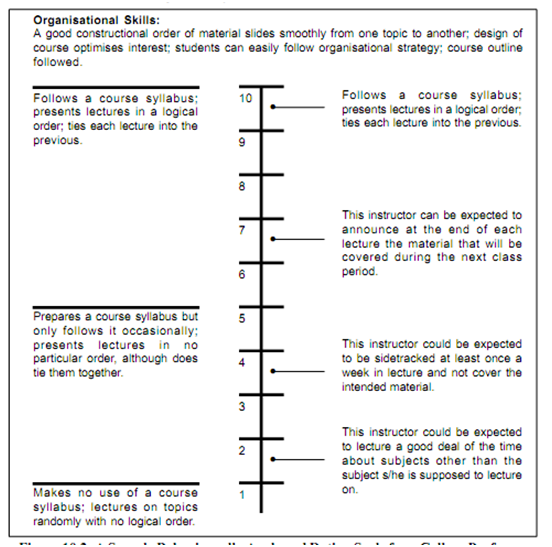Behaviourally anchored rating scales
It is also known as the behavioural expectations scale, this method represents the newest innovation in performance appraisal. This is a combination of the rating scale & critical incident techniques of workers performance evaluation. The critical incidents serve like anchor statements a scale & the rating form generally contains seven to eight specifically described performance dimensions.
How to construct BARS? Making BARS follows a common format which combines techniques working in the weighted checklist rating scales & critical incident method. Emphasis is pinpointed on pooling the thinking of persons who will utilize the scales as both evaluators & evaluees.
Step I: gather critical incidents: People with knowledge of the job to be probed, like job holders & supervisors, describe particular examples of effective and ineffective behaviour associated to job performance.
Step II: Identify performance dimensions: The people assigned the task of creating the instrument, gather the incidents into a small set of key performance dimensions. In general, among five & ten dimensions account for most of the performance. Instance of performance dimensions involve technical competence, relationships along customers, handling of paperwork & meeting day-to-day deadlines. When developing varying levels of performance for each of the dimension (anchors), particular examples of behaviour should be utilized, which could afterwards be scaled in terms of good, average or below average performance?
Step III: Reclassification of incidents: Another group of participants knowledgeable regarding the job is instructed to reclassify or retranslate the critical incidents produced (in Step II) previously. They are provided the definition of job dimension and told to assign each of the critical incidents to the dimension that it excellent describes. At this particular stage, incidents for which there is lower than 75% agreement are dropped as being too subjective.

Figure: A Sample Behaviourally Anchored Rating Scale for a College Professor
Step IV: Assigning scale values to the incidents: Each of the incidents is then rated on a one-to-seven or one-to-nine scale with respect of how good it represents performance on the suitable dimension. A rating of one represents unsuccessful performance; the top scale value shows very effective performance. Usually the second group of participants assigns the scale values. Means & standard deviations are calculated then for the scale values assigned to each of the incident. In general, incidents that have standard deviations of 1.50 or less (on a 7-point scale) are taken.
Step V: Producing the final instrument: Approximate six or seven incidents for each performance dimension - all having met the retranslating & standard deviation both criteria will be utilized as behavioural anchors. The ultimate BARS instrument consists of a series of vertical scales (one for each of dimension) anchored (or measured) by the last incidents. Each of the incidents is positioned on the scale in behalf of to its mean value.
Because the above procedure typically requires considerable workers participation, its acceptance by both supervisors & their subordinates can be greater. Proponents of BARS also claim that such kind of a system differentiates amongst performance, behaviour, and results and as a result is able to provide a basis for setting up developmental goals for the workers. Because this is job-specific and recognize observable and measurable behaviour, it is a more consistent and valid technique for performance appraisal.
After surveying several studies on BARS Researchers concluded that "despite the intuitive appeal of BARS, searching from research have not been encouraging". It has not evident to be greater to other methods in overcoming rater mistakes or in acquiring psychometric soundness. A particular deficiency is that the behaviours utilized are activity oriented instead of results oriented. This builds up a potential problem for supervisors doing the evaluation, who can be forced to deal with worker who are performing the activity but not completing the desired goals. Furthermore, it is time consuming and costly to create BARS. They also demand many appraisal forms to accommodate different kinds of jobs in an organisation. In a college, office clerks, lecturers, technical staff, library staff and gardening staff all have different kind of jobs; separate BARS forms would required to be developed for each. In view of the decline of compelling evidence demonstrating the superiority of BARS over traditional method as graphic rating scales, decotis concluded that: "It might be time to quit hedging concerning the efficacy of behavioural scaling strategies and conclude that this particular method has no clear-cut compensation over more traditional and simpler methods of performance evaluation".